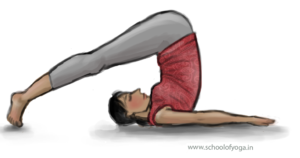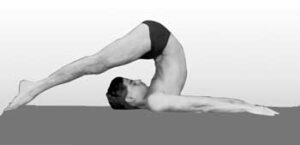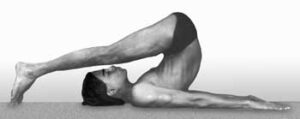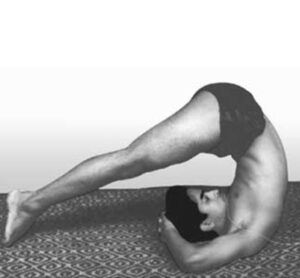 What is halāsana (plough pose)?
What is halāsana (plough pose)?
Halāsana is an advanced āsana. Here, the practitioner takes the legs over the face and stretches as far back as possible. Importantly, since there are many chances of mistakes, this āsana should be learned under supervision.
What is the halāsana technique? (should be learned under supervision)

- Sthithi (starting) position: First, lie on the back, hands to the side. Then, breathe in.
- Next, breathe out, and using back and leg muscles as support, lift legs off the floor, over the face to the rear of the head.
- Slowly, taking care not to jerk the neck, begin to stretch legs as far as possible.
- Importantly, ensure that there is equality in the stretch of the legs, legs are straight and that there is no distortion in the balance between the legs when stretching.
- Initially, the legs will bend and not stretch out straight. However, over time and with practice, final posture will be reached.
- At this point, the shoulder will support the back and will lock with the neck.
- Furthermore, the degree to which the legs are straightened and stretched away from the face indicates expertise in this āsana.

Yogacharya Sundaram demonstrating an intermediate position of halāsana - Importantly, maintain shallow breathing if unable to sustain a “breathing out” state.
- Also, hold 3 to 10 counts.
- Slowly, release the pressure on the back and bring the feet closer to the face.
- Breathing in, lift the legs and bring them back to the ground. Straighten the body.
- Relax, and breathe deeply. Repeat 3 to 6 times.
- The dṛṣṭi (gaze) recommended is focus on the neck-lock in the viśuddhi-cakra.
What are the benefits of practicing halāsana?
- First, this exercise is excellent for toning up nerves and muscles of the entire spine – neck, shoulders, upper and lower back, lower thigh muscles and hamstrings.
- Importantly, this āsana energises the cardio vascular system to a lesser extent.
- Lastly, in the final pose, where the head is held in a chin lock, the carotid artery is squeezed, thereby diverting blood to the thyroid. This improves the functioning of this critical component of the endocrine system.
What are the possible halāsana contraindications?
- First, if you have any form of back ache, do not attempt this āsana without adequate supervision and support from a professional.
- Importantly, people with cardiac problems, lower back problems and circulatory disorders should not attempt the final position.
- Also, do not perform this āsana if you have cervical spondylosis, hernia or arthritis.
- Lastly, this āsana should not be practiced during menstruation or pregnancy.
Some noteworthy points on halāsana
Internal Links: Dharma (conditioning), Stress and Situational Awareness, Prana, Asana sequence, Asana schedule, Asana Focus or gazing, Pranayama, Hatha Yoga Pradeepika
External Links: Prana, Chakra, Pancha Tattva, Pancha Prana, Pancha Kosha, Nadi,
-

Sundaramadhavan demonstrating halāsana While this exercise is very good for energizing the endocrine system, those with cervical or lumbar spondylosis should avoid this exercise completely.
- Initially, some would be tempted to use the hand to support the back when lifting and returning the legs to its original position. Whilst this is acceptable when one is learning the exercise, over time one should try to lift the legs and take it over the face to the rear without support as this strengthens the muscles of the lower back.
- Importantly, the use of the back to lift legs also results in increased sense of balance between left as well as right halves of the torso but one should be careful and not jerk or move too rapidly.
